Preventing Ventilator Associated Pneumonia in ICU: Evidence Based Practice
VerifiedAdded on 2023/06/10
|6
|1452
|165
AI Summary
This paper discusses the issue of Ventilator Associated Pneumonia (VAP) in ICU and identifies the best evidence based practice to prevent it. The paper explains the six steps of EBP process to identify the best evidence. The VAP bundle approach is found to be the most effective approach to prevent VAP. The paper also explains the critical appraisal process and the steps needed to properly integrate the evidence with clinical expertise.
Contribute Materials
Your contribution can guide someone’s learning journey. Share your
documents today.
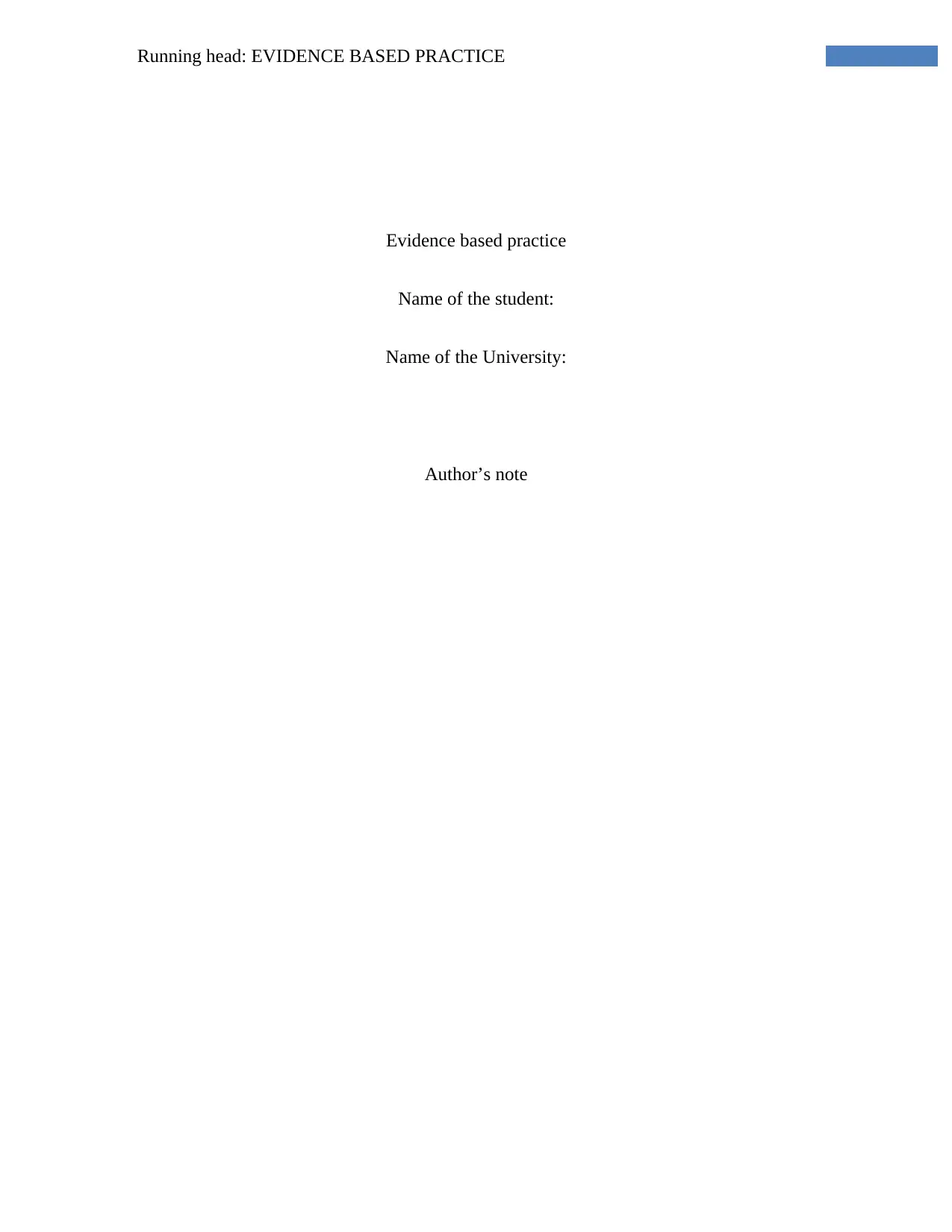
Running head: EVIDENCE BASED PRACTICE
Evidence based practice
Name of the student:
Name of the University:
Author’s note
Evidence based practice
Name of the student:
Name of the University:
Author’s note
Secure Best Marks with AI Grader
Need help grading? Try our AI Grader for instant feedback on your assignments.
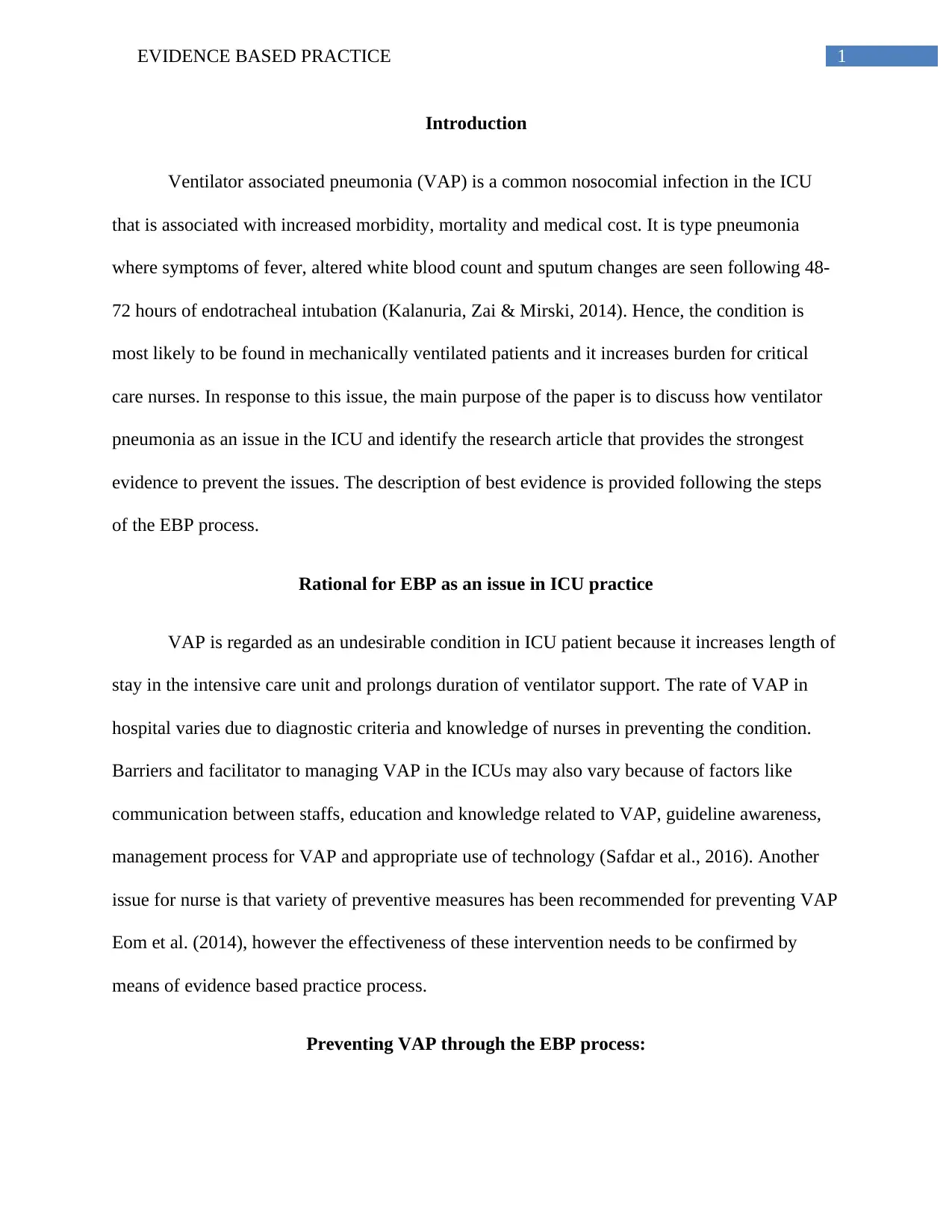
1EVIDENCE BASED PRACTICE
Introduction
Ventilator associated pneumonia (VAP) is a common nosocomial infection in the ICU
that is associated with increased morbidity, mortality and medical cost. It is type pneumonia
where symptoms of fever, altered white blood count and sputum changes are seen following 48-
72 hours of endotracheal intubation (Kalanuria, Zai & Mirski, 2014). Hence, the condition is
most likely to be found in mechanically ventilated patients and it increases burden for critical
care nurses. In response to this issue, the main purpose of the paper is to discuss how ventilator
pneumonia as an issue in the ICU and identify the research article that provides the strongest
evidence to prevent the issues. The description of best evidence is provided following the steps
of the EBP process.
Rational for EBP as an issue in ICU practice
VAP is regarded as an undesirable condition in ICU patient because it increases length of
stay in the intensive care unit and prolongs duration of ventilator support. The rate of VAP in
hospital varies due to diagnostic criteria and knowledge of nurses in preventing the condition.
Barriers and facilitator to managing VAP in the ICUs may also vary because of factors like
communication between staffs, education and knowledge related to VAP, guideline awareness,
management process for VAP and appropriate use of technology (Safdar et al., 2016). Another
issue for nurse is that variety of preventive measures has been recommended for preventing VAP
Eom et al. (2014), however the effectiveness of these intervention needs to be confirmed by
means of evidence based practice process.
Preventing VAP through the EBP process:
Introduction
Ventilator associated pneumonia (VAP) is a common nosocomial infection in the ICU
that is associated with increased morbidity, mortality and medical cost. It is type pneumonia
where symptoms of fever, altered white blood count and sputum changes are seen following 48-
72 hours of endotracheal intubation (Kalanuria, Zai & Mirski, 2014). Hence, the condition is
most likely to be found in mechanically ventilated patients and it increases burden for critical
care nurses. In response to this issue, the main purpose of the paper is to discuss how ventilator
pneumonia as an issue in the ICU and identify the research article that provides the strongest
evidence to prevent the issues. The description of best evidence is provided following the steps
of the EBP process.
Rational for EBP as an issue in ICU practice
VAP is regarded as an undesirable condition in ICU patient because it increases length of
stay in the intensive care unit and prolongs duration of ventilator support. The rate of VAP in
hospital varies due to diagnostic criteria and knowledge of nurses in preventing the condition.
Barriers and facilitator to managing VAP in the ICUs may also vary because of factors like
communication between staffs, education and knowledge related to VAP, guideline awareness,
management process for VAP and appropriate use of technology (Safdar et al., 2016). Another
issue for nurse is that variety of preventive measures has been recommended for preventing VAP
Eom et al. (2014), however the effectiveness of these intervention needs to be confirmed by
means of evidence based practice process.
Preventing VAP through the EBP process:
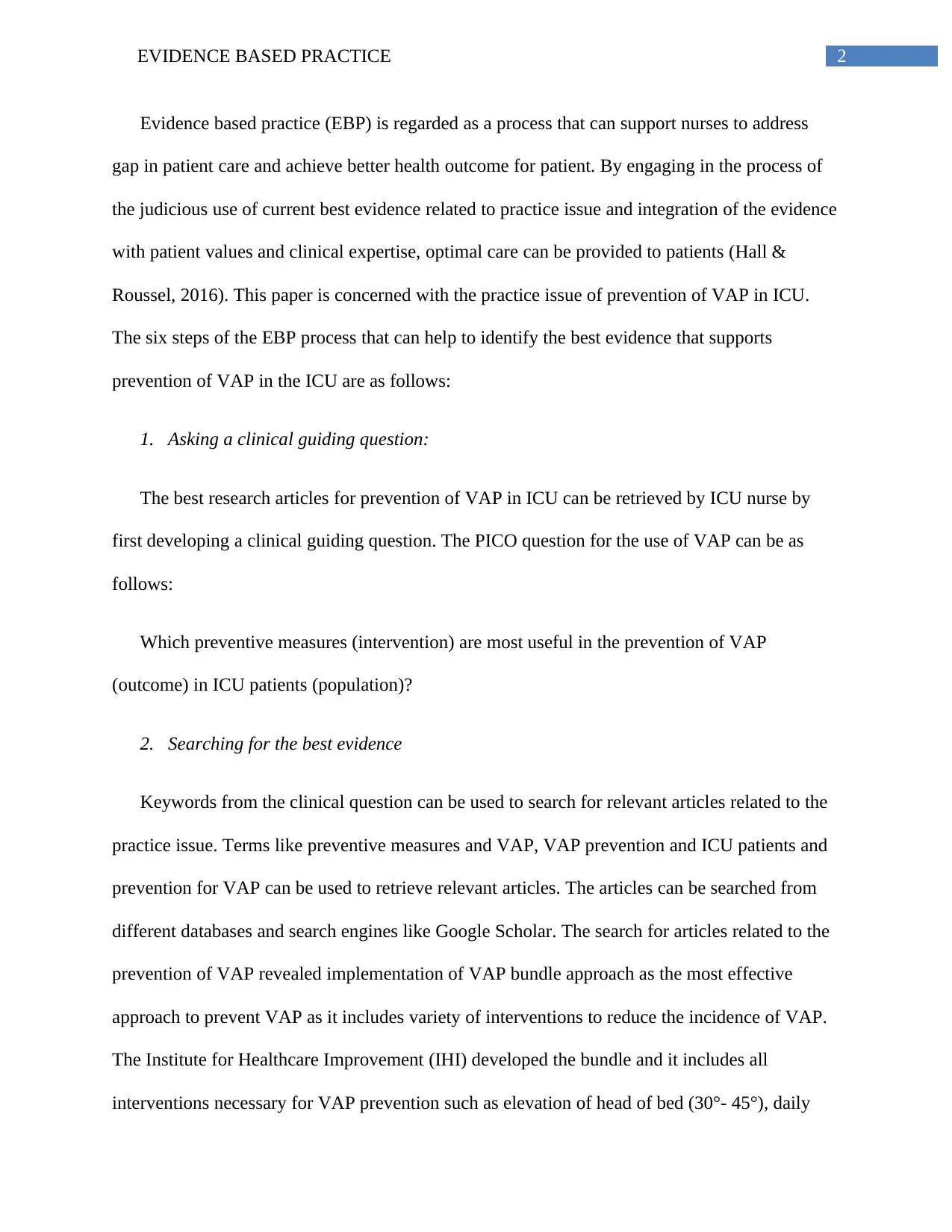
2EVIDENCE BASED PRACTICE
Evidence based practice (EBP) is regarded as a process that can support nurses to address
gap in patient care and achieve better health outcome for patient. By engaging in the process of
the judicious use of current best evidence related to practice issue and integration of the evidence
with patient values and clinical expertise, optimal care can be provided to patients (Hall &
Roussel, 2016). This paper is concerned with the practice issue of prevention of VAP in ICU.
The six steps of the EBP process that can help to identify the best evidence that supports
prevention of VAP in the ICU are as follows:
1. Asking a clinical guiding question:
The best research articles for prevention of VAP in ICU can be retrieved by ICU nurse by
first developing a clinical guiding question. The PICO question for the use of VAP can be as
follows:
Which preventive measures (intervention) are most useful in the prevention of VAP
(outcome) in ICU patients (population)?
2. Searching for the best evidence
Keywords from the clinical question can be used to search for relevant articles related to the
practice issue. Terms like preventive measures and VAP, VAP prevention and ICU patients and
prevention for VAP can be used to retrieve relevant articles. The articles can be searched from
different databases and search engines like Google Scholar. The search for articles related to the
prevention of VAP revealed implementation of VAP bundle approach as the most effective
approach to prevent VAP as it includes variety of interventions to reduce the incidence of VAP.
The Institute for Healthcare Improvement (IHI) developed the bundle and it includes all
interventions necessary for VAP prevention such as elevation of head of bed (30°- 45°), daily
Evidence based practice (EBP) is regarded as a process that can support nurses to address
gap in patient care and achieve better health outcome for patient. By engaging in the process of
the judicious use of current best evidence related to practice issue and integration of the evidence
with patient values and clinical expertise, optimal care can be provided to patients (Hall &
Roussel, 2016). This paper is concerned with the practice issue of prevention of VAP in ICU.
The six steps of the EBP process that can help to identify the best evidence that supports
prevention of VAP in the ICU are as follows:
1. Asking a clinical guiding question:
The best research articles for prevention of VAP in ICU can be retrieved by ICU nurse by
first developing a clinical guiding question. The PICO question for the use of VAP can be as
follows:
Which preventive measures (intervention) are most useful in the prevention of VAP
(outcome) in ICU patients (population)?
2. Searching for the best evidence
Keywords from the clinical question can be used to search for relevant articles related to the
practice issue. Terms like preventive measures and VAP, VAP prevention and ICU patients and
prevention for VAP can be used to retrieve relevant articles. The articles can be searched from
different databases and search engines like Google Scholar. The search for articles related to the
prevention of VAP revealed implementation of VAP bundle approach as the most effective
approach to prevent VAP as it includes variety of interventions to reduce the incidence of VAP.
The Institute for Healthcare Improvement (IHI) developed the bundle and it includes all
interventions necessary for VAP prevention such as elevation of head of bed (30°- 45°), daily
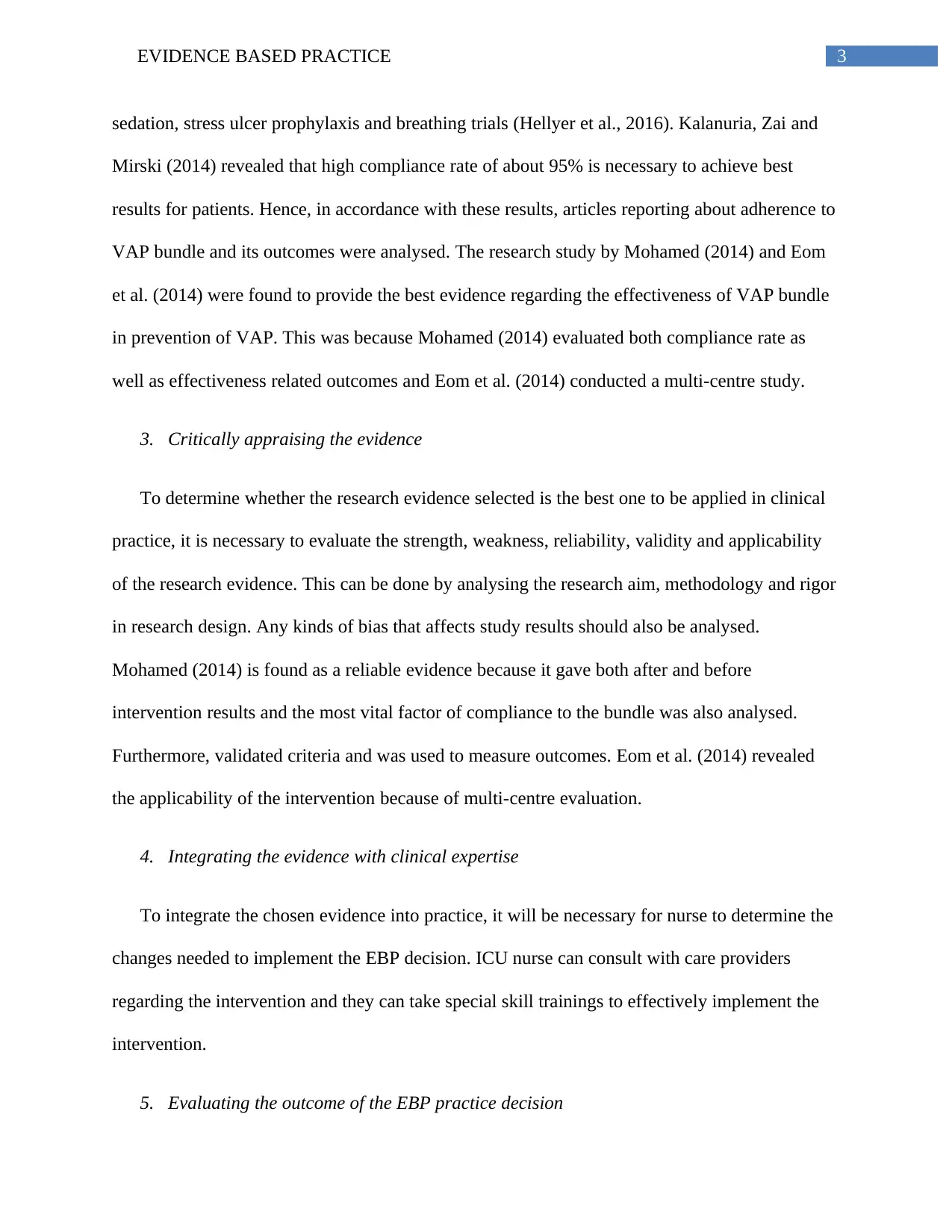
3EVIDENCE BASED PRACTICE
sedation, stress ulcer prophylaxis and breathing trials (Hellyer et al., 2016). Kalanuria, Zai and
Mirski (2014) revealed that high compliance rate of about 95% is necessary to achieve best
results for patients. Hence, in accordance with these results, articles reporting about adherence to
VAP bundle and its outcomes were analysed. The research study by Mohamed (2014) and Eom
et al. (2014) were found to provide the best evidence regarding the effectiveness of VAP bundle
in prevention of VAP. This was because Mohamed (2014) evaluated both compliance rate as
well as effectiveness related outcomes and Eom et al. (2014) conducted a multi-centre study.
3. Critically appraising the evidence
To determine whether the research evidence selected is the best one to be applied in clinical
practice, it is necessary to evaluate the strength, weakness, reliability, validity and applicability
of the research evidence. This can be done by analysing the research aim, methodology and rigor
in research design. Any kinds of bias that affects study results should also be analysed.
Mohamed (2014) is found as a reliable evidence because it gave both after and before
intervention results and the most vital factor of compliance to the bundle was also analysed.
Furthermore, validated criteria and was used to measure outcomes. Eom et al. (2014) revealed
the applicability of the intervention because of multi-centre evaluation.
4. Integrating the evidence with clinical expertise
To integrate the chosen evidence into practice, it will be necessary for nurse to determine the
changes needed to implement the EBP decision. ICU nurse can consult with care providers
regarding the intervention and they can take special skill trainings to effectively implement the
intervention.
5. Evaluating the outcome of the EBP practice decision
sedation, stress ulcer prophylaxis and breathing trials (Hellyer et al., 2016). Kalanuria, Zai and
Mirski (2014) revealed that high compliance rate of about 95% is necessary to achieve best
results for patients. Hence, in accordance with these results, articles reporting about adherence to
VAP bundle and its outcomes were analysed. The research study by Mohamed (2014) and Eom
et al. (2014) were found to provide the best evidence regarding the effectiveness of VAP bundle
in prevention of VAP. This was because Mohamed (2014) evaluated both compliance rate as
well as effectiveness related outcomes and Eom et al. (2014) conducted a multi-centre study.
3. Critically appraising the evidence
To determine whether the research evidence selected is the best one to be applied in clinical
practice, it is necessary to evaluate the strength, weakness, reliability, validity and applicability
of the research evidence. This can be done by analysing the research aim, methodology and rigor
in research design. Any kinds of bias that affects study results should also be analysed.
Mohamed (2014) is found as a reliable evidence because it gave both after and before
intervention results and the most vital factor of compliance to the bundle was also analysed.
Furthermore, validated criteria and was used to measure outcomes. Eom et al. (2014) revealed
the applicability of the intervention because of multi-centre evaluation.
4. Integrating the evidence with clinical expertise
To integrate the chosen evidence into practice, it will be necessary for nurse to determine the
changes needed to implement the EBP decision. ICU nurse can consult with care providers
regarding the intervention and they can take special skill trainings to effectively implement the
intervention.
5. Evaluating the outcome of the EBP practice decision
Secure Best Marks with AI Grader
Need help grading? Try our AI Grader for instant feedback on your assignments.
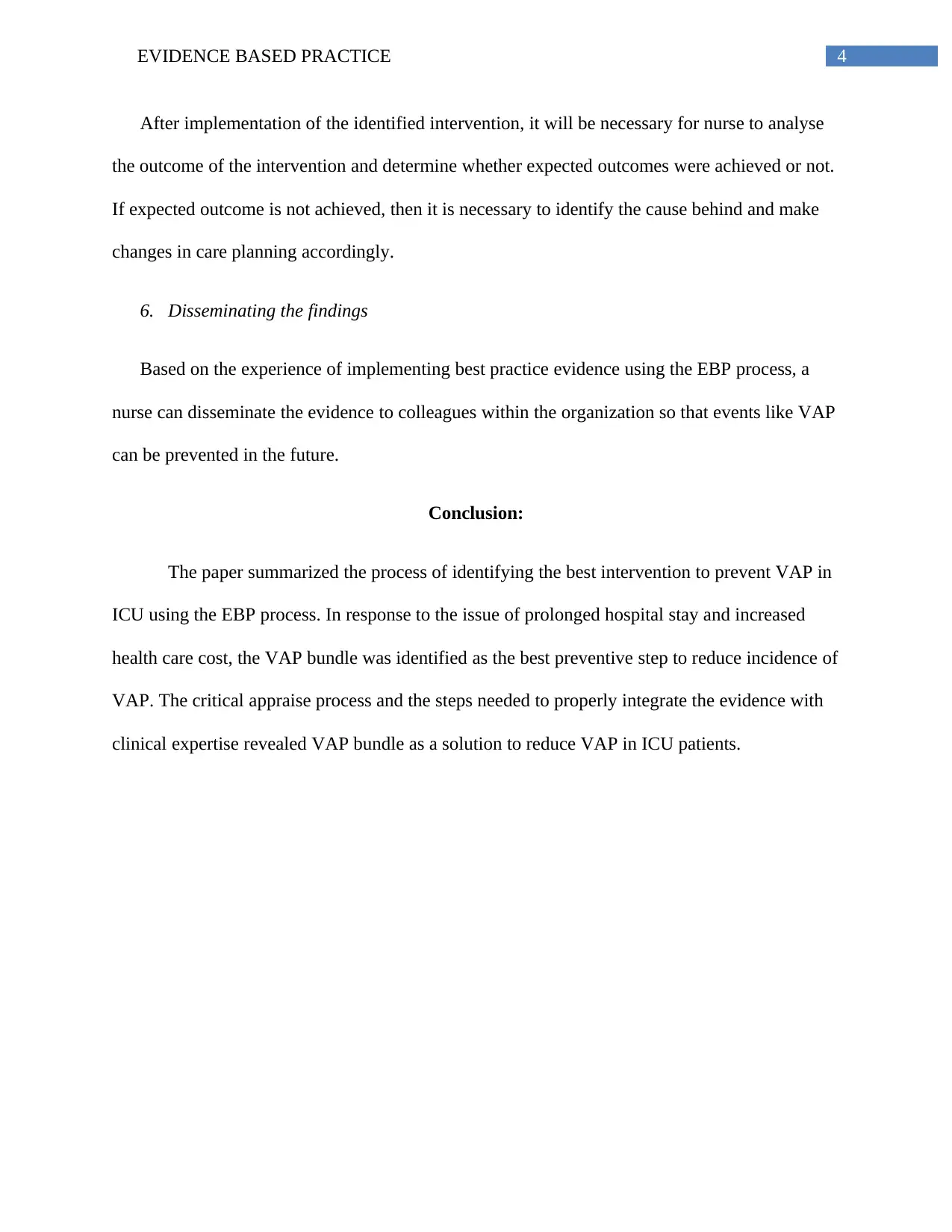
4EVIDENCE BASED PRACTICE
After implementation of the identified intervention, it will be necessary for nurse to analyse
the outcome of the intervention and determine whether expected outcomes were achieved or not.
If expected outcome is not achieved, then it is necessary to identify the cause behind and make
changes in care planning accordingly.
6. Disseminating the findings
Based on the experience of implementing best practice evidence using the EBP process, a
nurse can disseminate the evidence to colleagues within the organization so that events like VAP
can be prevented in the future.
Conclusion:
The paper summarized the process of identifying the best intervention to prevent VAP in
ICU using the EBP process. In response to the issue of prolonged hospital stay and increased
health care cost, the VAP bundle was identified as the best preventive step to reduce incidence of
VAP. The critical appraise process and the steps needed to properly integrate the evidence with
clinical expertise revealed VAP bundle as a solution to reduce VAP in ICU patients.
After implementation of the identified intervention, it will be necessary for nurse to analyse
the outcome of the intervention and determine whether expected outcomes were achieved or not.
If expected outcome is not achieved, then it is necessary to identify the cause behind and make
changes in care planning accordingly.
6. Disseminating the findings
Based on the experience of implementing best practice evidence using the EBP process, a
nurse can disseminate the evidence to colleagues within the organization so that events like VAP
can be prevented in the future.
Conclusion:
The paper summarized the process of identifying the best intervention to prevent VAP in
ICU using the EBP process. In response to the issue of prolonged hospital stay and increased
health care cost, the VAP bundle was identified as the best preventive step to reduce incidence of
VAP. The critical appraise process and the steps needed to properly integrate the evidence with
clinical expertise revealed VAP bundle as a solution to reduce VAP in ICU patients.
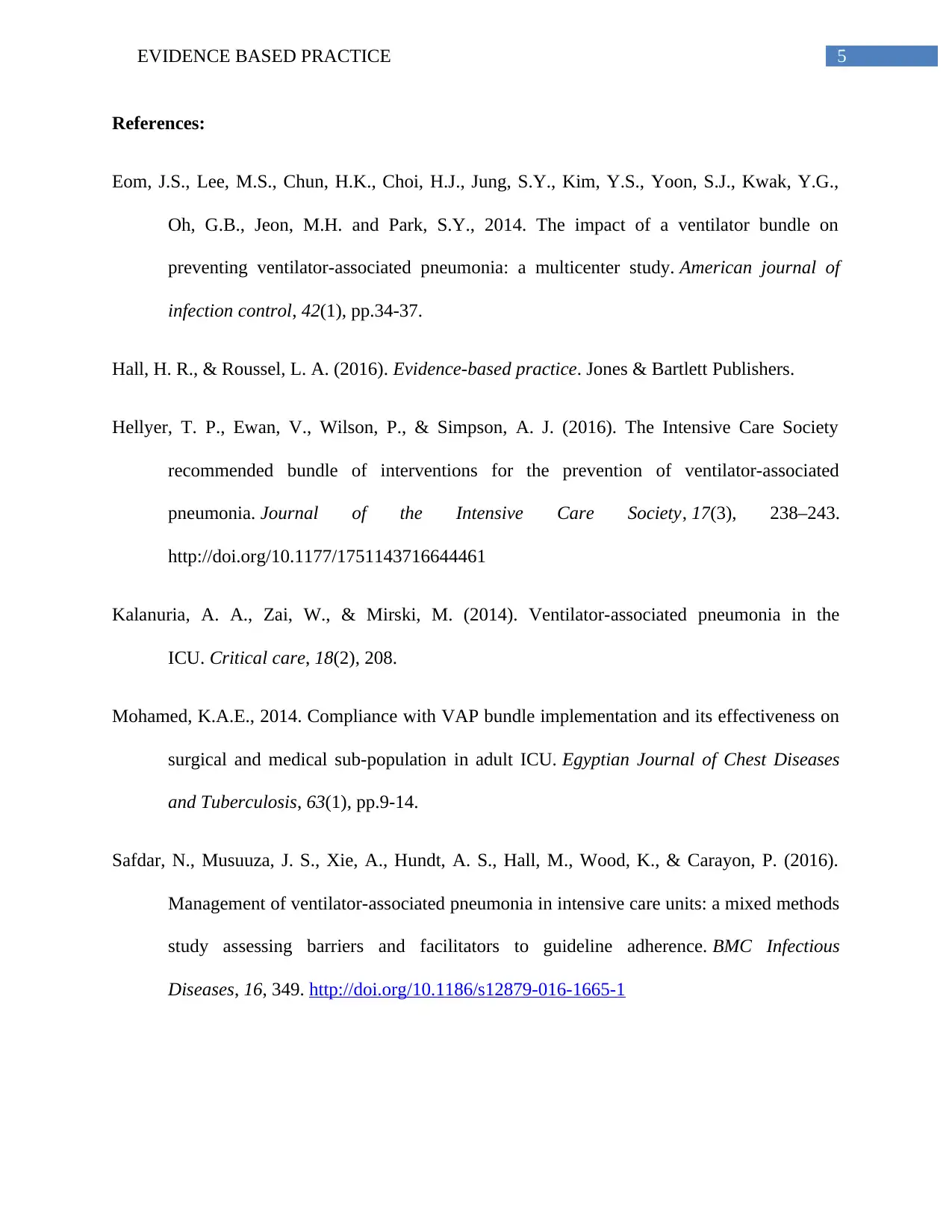
5EVIDENCE BASED PRACTICE
References:
Eom, J.S., Lee, M.S., Chun, H.K., Choi, H.J., Jung, S.Y., Kim, Y.S., Yoon, S.J., Kwak, Y.G.,
Oh, G.B., Jeon, M.H. and Park, S.Y., 2014. The impact of a ventilator bundle on
preventing ventilator-associated pneumonia: a multicenter study. American journal of
infection control, 42(1), pp.34-37.
Hall, H. R., & Roussel, L. A. (2016). Evidence-based practice. Jones & Bartlett Publishers.
Hellyer, T. P., Ewan, V., Wilson, P., & Simpson, A. J. (2016). The Intensive Care Society
recommended bundle of interventions for the prevention of ventilator-associated
pneumonia. Journal of the Intensive Care Society, 17(3), 238–243.
http://doi.org/10.1177/1751143716644461
Kalanuria, A. A., Zai, W., & Mirski, M. (2014). Ventilator-associated pneumonia in the
ICU. Critical care, 18(2), 208.
Mohamed, K.A.E., 2014. Compliance with VAP bundle implementation and its effectiveness on
surgical and medical sub-population in adult ICU. Egyptian Journal of Chest Diseases
and Tuberculosis, 63(1), pp.9-14.
Safdar, N., Musuuza, J. S., Xie, A., Hundt, A. S., Hall, M., Wood, K., & Carayon, P. (2016).
Management of ventilator-associated pneumonia in intensive care units: a mixed methods
study assessing barriers and facilitators to guideline adherence. BMC Infectious
Diseases, 16, 349. http://doi.org/10.1186/s12879-016-1665-1
References:
Eom, J.S., Lee, M.S., Chun, H.K., Choi, H.J., Jung, S.Y., Kim, Y.S., Yoon, S.J., Kwak, Y.G.,
Oh, G.B., Jeon, M.H. and Park, S.Y., 2014. The impact of a ventilator bundle on
preventing ventilator-associated pneumonia: a multicenter study. American journal of
infection control, 42(1), pp.34-37.
Hall, H. R., & Roussel, L. A. (2016). Evidence-based practice. Jones & Bartlett Publishers.
Hellyer, T. P., Ewan, V., Wilson, P., & Simpson, A. J. (2016). The Intensive Care Society
recommended bundle of interventions for the prevention of ventilator-associated
pneumonia. Journal of the Intensive Care Society, 17(3), 238–243.
http://doi.org/10.1177/1751143716644461
Kalanuria, A. A., Zai, W., & Mirski, M. (2014). Ventilator-associated pneumonia in the
ICU. Critical care, 18(2), 208.
Mohamed, K.A.E., 2014. Compliance with VAP bundle implementation and its effectiveness on
surgical and medical sub-population in adult ICU. Egyptian Journal of Chest Diseases
and Tuberculosis, 63(1), pp.9-14.
Safdar, N., Musuuza, J. S., Xie, A., Hundt, A. S., Hall, M., Wood, K., & Carayon, P. (2016).
Management of ventilator-associated pneumonia in intensive care units: a mixed methods
study assessing barriers and facilitators to guideline adherence. BMC Infectious
Diseases, 16, 349. http://doi.org/10.1186/s12879-016-1665-1
1 out of 6
Related Documents
Your All-in-One AI-Powered Toolkit for Academic Success.
+13062052269
info@desklib.com
Available 24*7 on WhatsApp / Email
![[object Object]](/_next/static/media/star-bottom.7253800d.svg)
Unlock your academic potential
© 2024 | Zucol Services PVT LTD | All rights reserved.





